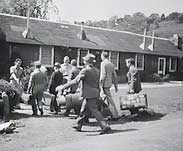|
Thirty-seven thousand conscientious objectors performed alternative service during WWII. They volunteered for tasks that few others were willing to perform. As medics on the battlefield, medical guinea pigs, smoke jumpers, attendants in mental institutions and workers in Civilian Public Service (CPS) camps, they served their country in dramatic and dangerous ways.
CPS Camps
Civilian Public Service was the product of a unique and conflicted collaboration between the U.S. government's Selective Service and the traditional peace churches: Mennonites, Church of the Brethren and Quakers. It was a response to the first peacetime draft in U.S. history, initiated more than a year before Pearl Harbor. It was also the first time conscientious objectors to war were offered legal alternative service under civilian command. The churches' goal was to protect COs from the torture they suffered in WWI and allow them to do "work of national importance" as an alternative to military service. The government's interest was primarily to keep the COs out of sight, so they would not have a negative impact on wartime morale. CPS men were not limited to members of the peace churches; they represented over 200 religious groups and others without church affiliation. Their only shared philosophy was the rejection of war.
| |
 COs arrive at camp |
Men who began arriving at the camps in 1941 expected to stay for six months. Instead, they would stay in the camps for the duration of the war, some serving six years, and were not released until 1947, two years after the end of the war. In CPS they would be required to work nine-hour days, six days a week at hard labor, and were expected to pay the government $35 a month for their room and board. Those who could pay did. At great cost to their congregations, the peace churches paid the fee for most of the COs and gave them $2.50 a month for expenses. There was no support for their families, many of whom spent the war years in dire poverty. The work they were assigned was often "make-work," and in camps, COs were most often frustrated in their desire to do the "work of national importance" they had been promised.
Church leaders held onto a belief that CPS was an opportunity to create utopian pacifist communities, a spiritually-based "witness to peace in a time of war."
 Steve Cary |
The clientele, the assignees, made the place an absolute zoo. I mean, we had Ph.Ds, we had winners of Fulbright prizes, we had guys who had a third-grade education, we had stockbrokers, we had ballet dancers, we had atheists, we had fundamentalists...every possible kind of human being was there....And that made it a fascinating place to be.
- Steve Cary, WWII CO |
World War II legal conscientious objectors had two choices: alternative work in the Civilian Public Service camps or non-combatant service in the Armed Forces. The CPS camps became incubators for many of the techniques of non-violent resistance used later in the civil rights and peace movements. Unsatisfied with the menial work assignments, the lack of financial support and the poor treatment they received in CPS camps, many men left the camps in protest and joined their comrades behind bars.
|
